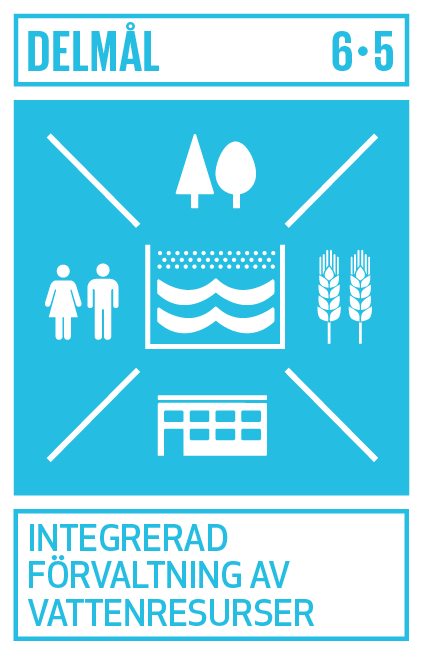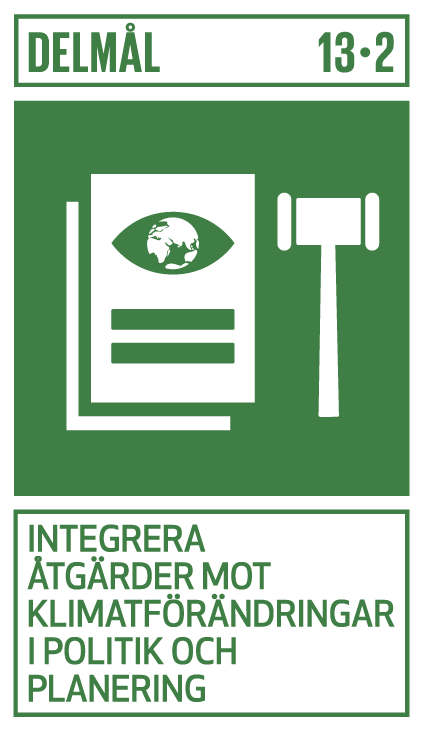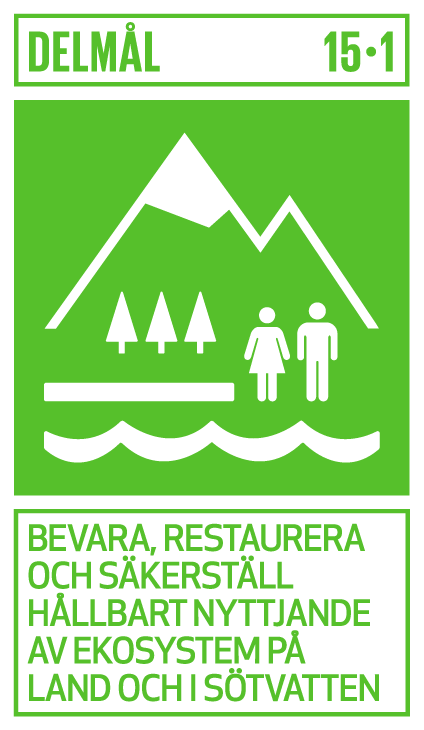Contents of this page may be automatically translated, we take no responsibility for the accuracy of the translation. Feel free to contact our customer support centre if you have any questions.

As the Swedish environmental goals are benchmarks for Sweden's environmental work and show the way to the ecological dimension of Agenda 2030, Lantmäteriet contributes to both Agenda 2030 and our national environmental goals through our products and services. .
Sub-goal 6.5
Sub-goal 6.5 means to integrate management of water resources. Water management will become increasingly important in a changing climate. Lantmäteriet contributes to the Swedish water management through both procedures and hydrography in networks.
Water areas
Through procedure Lantmäteriet can investigate the ownership and extent of water areas and the demarcation between them and determine whether the water area is public, private or joint. Lantmäteriet can thus determine how much different properties have in the current water - which can be decisive for how to use the water for e.g. fishing and tourism.
In a surveying service, there is also the possibility of securing the right to water in individual or common water wells. Lantmäteriet also forms, if necessary, management rights that ensure the right to buried transmission lines for water remains untouched.
Network hydrography
Using laser data, aerial images and altitude data, Lantmäteriet together with SMHI maintains a national database. The database contributes to the management of water, with a better basis for environmental initiatives, risk and vulnerability measures, emission analyzes and disaster planning in the event of floods.
Sub-goal 13.1
Sub-goal 13.1 means to strengthen resilience to and adaptability to climate-related disasters. Lantmäteriet 's geodata is an essential part of society's planning of preventive measures for climate change.
Within the national geodata strategy, climate adaptation is one of four societal challenges where geodata can contribute to society's development. By several authorities working together to identify, improve and make available geodata, this contributes to a more efficient climate adaptation of society. Read more about the geodata strategy.
Geodata are important for showing the effects of climate change
Lantmäteriet 's geodata are important data for showing the effects of climate change. Usage examples:
- The national elevation model, based on airborne laser scanning, is used for flood mapping but also to identify areas where there is a risk of landslides and avalanches.
- The hydrographic network provides the opportunity to follow the water's path through the landscape and eg analyze how pollutants from flooded areas spread in watercourses.
- Aerial photos from different time periods provide a good opportunity to follow changes in the landscape over time.
- Laser scanning and surface model from aerial images , can be used to calculate forest growth and other basic forest data and elevate data to 3D.
Since most effects of climate change have a geographical connection, access to uniform and easily accessible geodata is of central importance for analyzes , k sequence descriptions and planning of various climate adaptation measures.
Sub-goal 13.2
Sub-goal 13.2 means to integrate measures against climate change into policy and planning.
Lantmäteriet 's products and services can in various ways contribute to other societal actors and companies for to analyze, plan to reduce the impact on our climate. For example:
- SWEPOS - satellite positioning that can be used for guiding construction machinery but also for climate research. More about SWEPOS .
- GNSS measurement of water vapor - In weather and climate applications, the atmospheric content of water vapor is important information. Since 2016, Lantmäteriet calculations of data from almost 700 stations; mainly Nordic ones. Read more here: E-GVAP, the EUMETNET GNSS Water Vapor Program
- Prepare Ships - positioning solution to increase the safety and efficiency of maritime transport. Read more here: Prepare Ships
- Redistribution - enables more efficient forestry through reduced transport.
Sub-goal 15.1
Sub-goal 15.1 means to preserve, restore and ensure sustainable use of ecosystems on land and in freshwater.
Lantmäteriet 's surface model, which is based on up-to-date laser data will be make great use of society, not least where you want to be able to analyze and visualize changes in the landscape.
The ongoing glacier reduction is clearly visible in Lantmäteriet 's laser data on the mountain world. Lantmäteriet 's provision of satellite data - Saccess - also contributes to studying changes in the Swedish landscape. Lantmäteriet 's image information from several eras is also used to follow changes in vegetation and buildings.
Lantmäteriet's laser data contributes greatly to national forest basic data and forms the basis for a new national forest map which is an important tool for developed forest planning and more efficient forest management.
In some parts of Sweden there is a very fragmented property structure as a result of a tradition where land is divided equally between the heirs, both male and female. This has led to many small parcels of ownership and complicated ownership.
Through redevelopment, many small and scattered parcels are brought together into larger units with the aim of creating conditions for more efficient forestry and agriculture. Redevelopment is also about making better use of cultural and natural values. Re-rounding also creates conditions for the formation of different types of protected areas, such as nature reserves or natura 2000.





